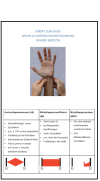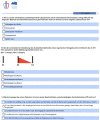Significant differences in written assessments as a result of a blended learning approach used in a clinical examination course in internal medicine: a randomized controlled pilot study
- PMID: 33763527
- PMCID: PMC7958916
- DOI: 10.3205/zma001438
Significant differences in written assessments as a result of a blended learning approach used in a clinical examination course in internal medicine: a randomized controlled pilot study
Abstract
Background: Taking a medical history and performing a physical examination represent basic medical skills. However, numerous national and international studies show that medical students and physicians-to-be demonstrate substantial deficiencies in the proper examination of individual organ systems. Aim: The objective of this study was to conduct a randomized controlled pilot study to see if, in the context of a bedside clinical examination course in internal medicine, an additional app-based blended-learning strategy resulted in (a) higher satisfaction, better self-assessments by students when rating their history-taking skills (b1) and their ability to perform physical examinations (b2), as well as (c) higher multiple-choice test scores at the end of the course, when compared to a traditional teaching strategy. Methods: Within the scope of a bedside course teaching the techniques of clinical examination, 26 students out of a total of 335 students enrolled in the 2012 summer semester and 2012/2013 winter semester were randomly assigned to two groups of the same size. Thirteen students were in an intervention group (IG) with pre- and post-material for studying via an app-based blended-learning tool, and another 13 students were in a control group (CG) with the usual pre- and post-material (handouts). The IG was given an app specifically created for the history-taking and physical exam course, an application program for smartphones enabling them to view course material directly on the smartphone. The CG received the same information in the form of paper-based notes. Prior to course begin, all of the students filled out a questionnaire on sociodemographic data and took a multiple-choice pretest with questions on anamnesis and physical examination. After completing the course, the students again took a multiple-choice test with questions on anamnesis and physical examination. Results: When compared to the CG, the IG showed significantly more improvement on the multiple-choice tests after taking the clinical examination course (p=0.022). This improvement on the MC tests in the IG significantly correlated with the amount of time spent using the app (Spearman's rho=0.741, p=0.004). Conclusion: When compared to conventional teaching, an app-based blended-learning approach leads to improvement in test scores, possibly as a result of more intensive preparation for and review of the clinical examination course material.
Hintergrund: Die Erhebung der Anamnese und die Durchführung körperlicher Untersuchungstechniken stellen eine grundlegende Kompetenz des ärztlichen Handelns dar. Allerdings zeigen zahlreiche nationale und internationale Studien, dass bei Medizinstudierenden und angehenden Ärzten erhebliche Defizite in der korrekten Durchführung der körperlichen Untersuchung einzelner Organsysteme vorliegen.Zielsetzung: Ziel der vorliegenden Studie war es, in einer randomisiert-kontrollierten Pilotstudie zu überprüfen, ob im Rahmen eines internistischen Bedside-Teaching ein zusätzliches App-basiertes Blended-Learning-Konzept im Vergleich zum klassischen Lehrkonzept (a) zu einer höheren Zufriedenheit, zu einer besseren Selbsteinschätzung der Studierenden bezüglich der Anamneseerhebung (b1) und der Durchführung der körperlichen Untersuchung (b2), als auch (c) zu besseren Multiple-Choice (MC)-Prüfungsergebnissen am Ende des Kurses führt.Methodik: Im Rahmen des internistischen Untersuchungskurses / Bedside-Teaching wurden von insgesamt 335 Studierenden des Sommersemesters 2012 und des Wintersemesters 2012/2013 26 Studierende randomisiert zwei gleich großen Gruppen zugewiesen: 13 Studierende einer Interventionsgruppe (IG) mit Vor- und Nachbereitungsmaterial anhand eines App-basierten Blended-Learning-Konzepts und 13 Studierende einer Kontrollgruppe (KG) mit konventionellem Vor- und Nachbereitungsmaterial (Handout). Die IG erhielt eine auf den Anamnese- und Untersuchungskurs zugeschnitte App, ein Anwendungsprogramm für Smartphones, das es ermöglicht, Lehrmaterial für den Untersuchungskurs direkt auf dem Smartphone einzusehen. Die KG erhielt dieselben Informationen anhand von Skripten. Vor Beginn des Untersuchungskurses füllten alle Studierenden Fragebögen zu soziodemographischen Daten aus und nahmen an einer Eingangs-MC-Klausur mit MC-Fragen zur Anamnese und körperlicher Untersuchung teil. Nach Abschluss des Untersuchungskurses nahmen die Studierenden erneut an einer MC-Klausur mit MC-Fragen zu Anamnese und körperlicher Untersuchung teil.Ergebnisse: Die IG zeigte im Vergleich zur KG eine signifikant höhere Verbesserung in den MC-Klausuren nach Durchlaufen des Untersuchungskurses (p=0,022). Die Verbesserung in den MC-Klausuren korrelierte in der IG signifikant mit der zeitlichen Beschäftigung mit der App (Spearmans rho=0.741, p=0.004). Schlussfolgerung: Ein App-basiertes Blended-Learning-Konzept führt im Vergleich zum klassischen Lehrkonzept, möglicherweise durch einer intensivere Vor- und Nachbereitung des klinischen Untersuchungskurses, zu einer Verbesserung in den Prüfungsergebnissen.
Keywords: app; blended learning; course on physical examination techniques.
Copyright © 2021 Sonne et al.
Conflict of interest statement
The authors declare that they have no competing interests.
Figures








References
-
- Aldeen AZ, Gisondi MA. Bedside teaching in the emergency department. Acad Emerg Med. 2006;13(8):860–866. - PubMed
Publication types
MeSH terms
LinkOut - more resources
Full Text Sources
Medical

